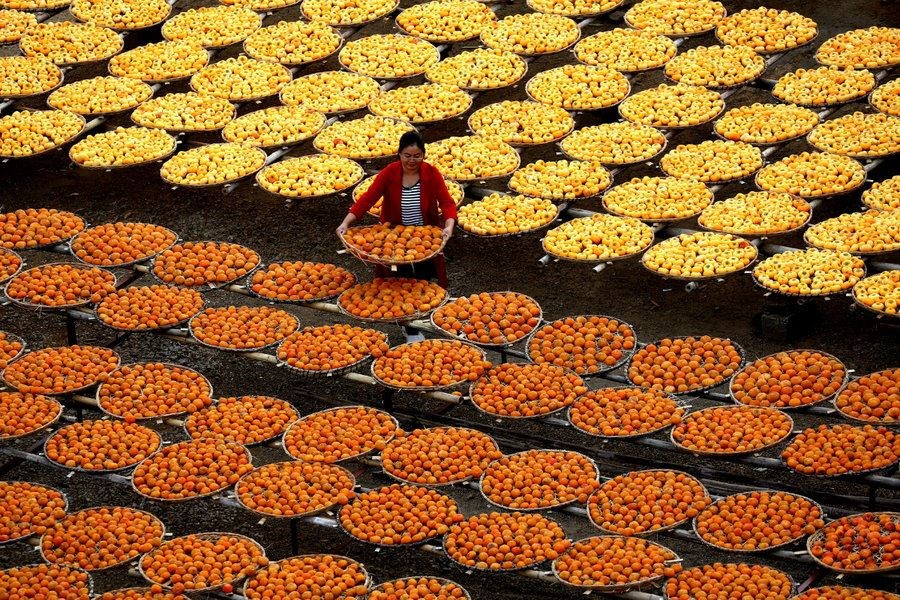Reprinted with permission from The Christian Science Monitor
While researching medlars I discovered that there’s a wonderful old word, dating back to Shakespeare as well, that’s still employed by botanists to categorize fruit: climacteric.
I’ve wanted to try a medlar fruit ever since I first saw it mentioned in Shakespeare, and recently I got the chance. To me it tasted like a date and looked like a cross between a rose hip and an apple, but to Renaissance playwrights it resembled a part of the female anatomy. You’ll have to look it up in “Romeo and Juliet.” Medlars are inedible until they are extremely overripe, so soft that they fall apart in your fingers. They are “rotten ... ere half ripe,” as Shakespeare wrote. They only become sweet enough to eat once they begin to decay.
 A villager dries persimmons on rooftop at a village in Guilin, Guangxi Zhuang Autonomous Region, China, Nov. 4, 2017. Persimmons, like medlars (popular in the Renaissance), are climacteric fruits.Stringer/ReutersUntil the 19th century, the word for this overripening process was simply rot; medlars must be “laid by to rot,” one early garden authority advised. In 1835, though, a squeamish English botanist borrowed a term to make the process sound more decorous and appetizing: bletting, from the French for “overripe.” Hachiya persimmons and the fruit of the wild service tree (known in England as “chequers” or “checkers”) are likewise so astringent that they need to blet before they can be eaten.
A villager dries persimmons on rooftop at a village in Guilin, Guangxi Zhuang Autonomous Region, China, Nov. 4, 2017. Persimmons, like medlars (popular in the Renaissance), are climacteric fruits.Stringer/ReutersUntil the 19th century, the word for this overripening process was simply rot; medlars must be “laid by to rot,” one early garden authority advised. In 1835, though, a squeamish English botanist borrowed a term to make the process sound more decorous and appetizing: bletting, from the French for “overripe.” Hachiya persimmons and the fruit of the wild service tree (known in England as “chequers” or “checkers”) are likewise so astringent that they need to blet before they can be eaten.
Researching medlars I discovered that there’s a wonderful old word, dating back to Shakespeare as well, that’s still employed by botanists to categorize fruit: climacteric. From the 16th to 19th centuries, this word referred to a period of great change or upheaval, usually for the worse. It comes from the Greek klimakte-r, literally “rung of the ladder”; the Merriam-Webster dictionary explains that “English speakers have long used climacteric for those inevitable big moments encountered on the metaphorical ladder of life.” According to ancient Greek and early modern astrology, “climacteric years” were multiples of seven or nine and were full of potential pitfalls. The 63rd (seven times nine) year of a person’s life, the “grand climacteric,” was thought to be especially dangerous, and anyone who “passed his Grand Climacteric” unscathed was fortunate.
More recently, the word has come to be used for any critical time or epochal event, not necessarily a negative one. The moon landing was a climacteric event for the world; when I met my husband, it was a climacteric moment for me.
In botany, the word identifies a crucial distinction. “Climacteric fruits” ripen after they are picked. They produce ethylene gas and undergo a period of increased respiration, which causes them to soften and sweeten – metaphorically, it is a turning point in the “life” of the fruit. Apples, mangoes, bananas, peaches, and pears fall into this category. “Non-climacteric” fruits, in contrast, such as oranges, strawberries, raspberries, watermelons, and pineapples, give off much less gas, and thus do not ripen after harvest.
The medlar, that quintessential Renaissance fruit, is appropriately enough climacteric.
Page created on 12/14/2018 8:28:08 AM
Last edited 12/14/2018 8:40:07 AM
